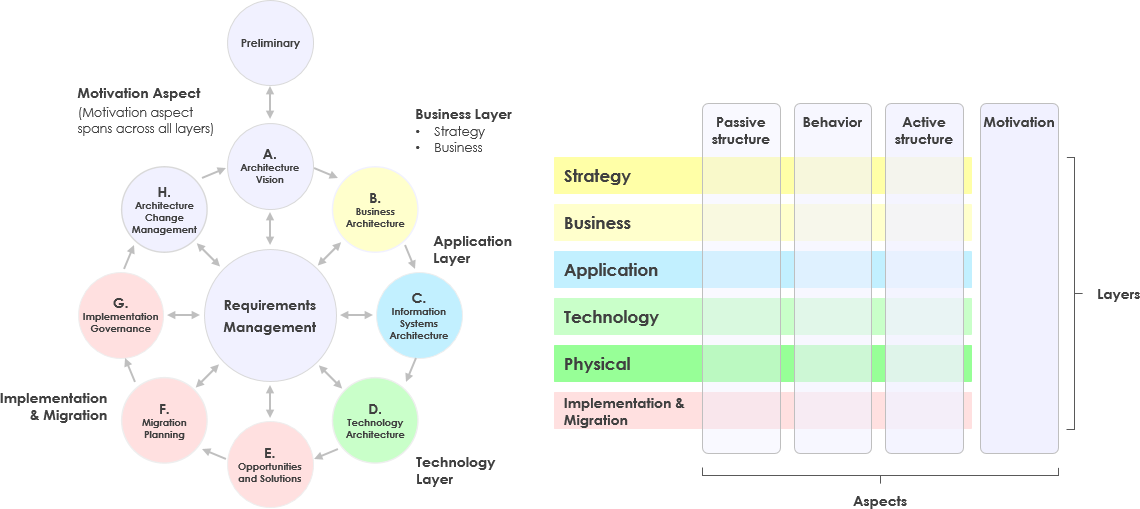TOGAF vs. ArchiMate: Can They Work Together?
Introduction
TOGAF (The Open Group Architecture Framework) and ArchiMate are two prominent frameworks in the field of enterprise architecture. While TOGAF provides a comprehensive methodology for developing and managing enterprise architectures, ArchiMate offers a modeling language specifically designed to visualize and describe architectural structures. This article explores the relationship between TOGAF and ArchiMate, examining whether they can work together and how organizations can benefit from their combined use.
Understanding TOGAF and ArchiMate
TOGAF
TOGAF is primarily a framework for enterprise architecture that outlines a structured approach for organizations to design, plan, implement, and govern their architecture. It includes:
- Architecture Development Method (ADM): A step-by-step process for creating and managing architectures.
- Content Framework: Guidelines on what to include in architectural deliverables.
- Enterprise Continuum: A model for classifying architecture and solution artifacts.
ArchiMate
ArchiMate, on the other hand, is a modeling language that provides a visual representation of enterprise architectures. It is designed to be:
- Comprehensive: Covering various layers of architecture, including business, application, and technology layers.
- Standardized: Offering a common notation for architects to communicate their designs clearly.
- Flexible: Allowing for the integration of various architecture frameworks and methodologies.
Can TOGAF and ArchiMate Work Together?
Yes, They Can!
TOGAF and ArchiMate can indeed complement each other effectively. Here’s why and how:
1. Enhanced Communication
- Shared Language: ArchiMate provides a standardized way to visualize the concepts outlined in TOGAF. This shared language enhances communication among stakeholders, making it easier to discuss architectural designs and decisions.
- Visual Representation: By using ArchiMate diagrams, organizations can present TOGAF’s architectural models in a more accessible format, facilitating better understanding among non-technical stakeholders.
2. Structured Approach with Visual Tools
- Framework Integration: TOGAF’s ADM can be supported by ArchiMate modeling at various phases. For example, during the “Architecture Vision” phase, ArchiMate can be used to create high-level models that convey the architectural vision.
- Documentation: Using ArchiMate alongside TOGAF can enhance documentation practices. The visual models created with ArchiMate can serve as valuable artifacts within the TOGAF framework, providing clarity and context to architectural deliverables.
3. Supporting Different Architectural Layers
- Layered Approach: TOGAF’s focus on different architectural domains (business, application, data, technology) aligns well with ArchiMate’s multi-layered modeling approach. This allows architects to create models that represent the architecture at various levels of abstraction.
- Alignment of Business and IT: By modeling business processes and IT systems together, organizations can ensure better alignment between business goals and IT capabilities, a key principle of both TOGAF and ArchiMate.
How to Integrate TOGAF and ArchiMate

1. Start with TOGAF
- Adopt TOGAF’s ADM: Begin by implementing TOGAF’s ADM to establish your architectural development process. This structured approach will help you define your architecture’s scope, requirements, and goals.
2. Utilize ArchiMate for Modeling
- Create ArchiMate Models: As you progress through the ADM phases, use ArchiMate to create models that represent the architecture being developed. Focus on visualizing the relationships between different components of the architecture.
3. Develop Artifacts
- Combine Models with TOGAF Deliverables: Integrate ArchiMate models into your TOGAF documentation. For example, include ArchiMate diagrams in your Architecture Definition Document to visualize key concepts and relationships.
4. Train Stakeholders
- Educate Teams on Both Frameworks: Provide training sessions for stakeholders to understand both TOGAF and ArchiMate. This will enable better collaboration and communication across teams.
5. Iterate and Adapt
- Refine Your Approach: Continuously assess how well TOGAF and ArchiMate are working together within your organization. Make adjustments based on feedback and evolving business needs.
Conclusion
TOGAF and ArchiMate can work together harmoniously to enhance enterprise architecture practices. By leveraging the structured methodology of TOGAF alongside the visual modeling capabilities of ArchiMate, organizations can improve communication, documentation, and alignment between business and IT. The integration of these two frameworks allows for a more holistic approach to enterprise architecture, ultimately driving business efficiency and success.

